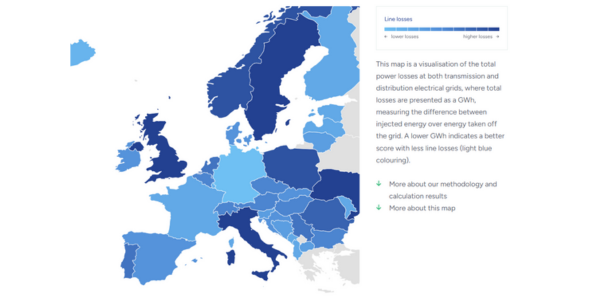CurrENT releases interactive online tool aimed at increasing the transparency around grid performance and the level of deployment of innovative grid technologies across European grids

Brussels, 3 June 2025 – CurrENT, the voice of innovative grid technologies in Europe, releases for the first time an interactive online tool aimed at increasing the transparency around grid performance and the level of deployment of innovative grid technologies across European grids. Using publicly available data, CurrENT has released two new key performance indicator maps on consumer electricity costs and network energy losses. These aim to transparently track the impact through deployment of innovative grid technologies across EU regions. The mapping of key performance in these areas acts as a call for Europe to illuminate benefits and push to deploy more innovation into the grid, increasing efficiency and lowering costs for consumers.
Layla Sawyer, Secretary General of CurrENT Europe said, “The electricity grid has rightly been highlighted as a key enabler of Europe’s decarbonisation and competitiveness targets, but a lack of data transparency across European networks still hinders developing a full understanding of the state of Europe’s grid. The purpose of these maps is to show how much there is to gain from deploying innovative grid technologies and where more data transparency is needed. These maps mark the start of CurrENT’s Compass, and we look forward to making the maps more granular as we plan to incorporate more data to improve this project going forward”.
Europe possesses a sophisticated and coordinated grid planning system which can act as a strong foundation for planning a future grid with innovation, making development plans become a reality. Europe must be able to scale investment and deployment to match its ambitious goals by selecting the most asset and material efficient timely solutions. This will necessitate wholesale adoption of innovation as part of a more conventional technology solution or in its place.
The principle of ‘efficiency first’ as a guiding methodology for grid investment is hindered by a lack of data to facilitate coordination between key stakeholders. To help alleviate these issues, CurrENT’s Grid Compass maps provide additional comparisons that can be used to help assess Europe’s grid. Increasing the speed of the deployment of innovative grid technologies, in line with the ‘efficiency first’ principle, is essential to reach our targets up to 2030 and beyond. Transparency around the levels of deployment of innovative grid technologies, as well as the performance of these networks measured along other key metrics, can help highlight their impact and accelerate their deployment as enablers of the energy transition. The CurrENT Grid Compass aims to start a conversation around grid performance.
“The European Commission’s Clean Industrial Deal calls to “boost innovation” to develop an efficient energy system” says Duncan Burt, Chair of CurrENT Europe’s Incentives Regulation Working Group, “the initial results of these maps shows that significant differences between networks across Europe, both in terms of end costs of electricity and the level of network losses. Some of the differences will relate to underlying geography and local grid dynamics but different approaches to the adoption of innovative technology can also help drive lower costs and more efficient outcomes whilst maintaining or enhancing the security of the grid. The principle of efficiency first investment decisions in grid is key to drive the European grid to the efficiency frontier. Innovative grid technologies must be part of the solution to these issues, amongst others, and transparency around the performance of grids can help highlight where specific technologies will be most impactful”.
CurrENT Europe invites TSOs, regulators, policymakers, industry stakeholders, and researchers to explore the CurrENT Grid Compass and provide feedback. See the CurrENT Grid Compass on our website here.
Following best practice, as part of this initiative CurrENT has performed a review of the publicly available data. While it concluded that it met the criteria to be able to provide valid results to support these maps, the data could be greatly improved correcting for geographical differences and has data limitations. As part of its development of a second edition of these maps, CurrENT would welcome as part of its engagement with stakeholders to consult on improving these public data sources.